Agricultural Communities, Early Period
Agricultural Communities, Early Period Archaeological research over the last four decades or so has revealed that Bengal had a discrete culture which dates back to middle to late Pleistocene period (0.6 - 0.1 million years before present). Macro level study reveals the homogeneity of Stone Age culture with the neighbouring states of Bihar and orissa, but a micro level study suggests that Bengal had a distinct cultural identity of its own, which contributed to the process of making of the later Bengali culture. The recent discoveries of flake-blade element and Neolithic Celts, adzes and other types on fossilised wood from eastern Bangladesh bordering Burma have added new dimension to the study of stone age culture of the region. Bengal includes both West-Bengal and Bangladesh, but the evidence of early agricultural communities was confined to its southwestern part only.
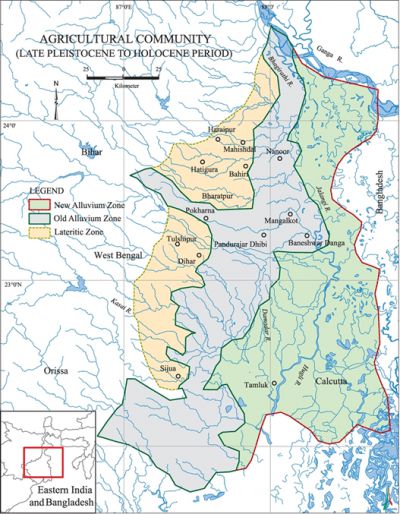
The incidental discovery of Neolithic Celts from the lower levels of Chalcolithic culture at pandu rajar dhibi, Bharatpur and Tamluk should be viewed in the context of agriculture based Chalcolithic economy. So, in the absence of stratified evidence of Neolithic culture in Bengal, the Chalcolithic culture may be taken as representing the earliest known agricultural communities of Bengal. They were confined to 86°23'-88°22' east longitudes and 24°15'-23°58' north latitudes. This region known as Western plain extends up to Plateau fringe in the west to Ganga/Bhagirathi in the east and Ganga/Padma in the north to Bay of Bengal in the south. This region mainly drained by Ajoy/Damodar/Kasai/Rupnarayan and Mayuraksi rivers has witnessed the emergence of first settled agricultural communities of Bengal around 1500 BC. Initially they were confined to the lateritic zone of Lalgarh formation and then they moved to east and southeast direction. The recognition of Proto-historic cultures came through the discovery of Black and Red ware from Pandu Rajar Dhibi. Subsequently the site was taken up for excavation in 1962 and since then many more sites yielding black and red ware have been reported from this region.
The excavation at Pandu Rajar Dhibi provides us a broad spectrum of early agricultural communities in Bengal. Initially this culture was labelled as Chalcolithic, but in view of recent researches the term Chalcolithic seems to be a misnomer particularly in view of the discovery of large quantities of iron objects including ore, slag and finished tools from Chalcolithic level. At present it is preferable to designate this particular cultural phase as simple Black and Red ware culture till a suitable term is found.
Agriculture as a major form of subsistence base was first manifest in Bengal around 1500 BC. Altogether 78 Chalcolithic or Black and Red ware sites have been identified. The sites are located in three different soil formations. It appears from the nature of distribution that the largest numbers of sites are found in the Lateritic soil (Lalgarh formation) followed by old alluvium (Sijua formation), while lesser number of sites is found in the new alluvium soil (Daintikri formation). The major concentrations of sites are found in the region, comprising both lateritic and old alluvium soil formations, around Ajoy/Damodar river system.
Kherur in Murshidabad is the northern limit of this culture while Natsal/Tamluk in Midnapur is the southern limit. The eastern limit of this culture extends up to Purbasthali in eastern Burdwan, while its western limit can be traced at Deultarn in Purulia. For reasons not clear to us, the early agricultural communities avoided in extending their settlement to the eastern side of Bhagirathi. However, altogether 78 sites have been found on the western side of the Bhagirathi, which alone speaks of the potentiality of the area.
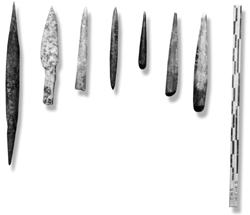
Excavated Sites Out of 78 sites, 14 have been excavated so far. The excavations have provided the basic and important information pertaining to life and culture of early agricultural communities of Bengal. Of the excavated sites, Tamluk, Bharatpur, Mahisdal, Haraipur, Tulshipur and Nanoor have been excavated by Archaeological survey of India; Pandu Rajar Dhibi, Baneshwardanga and Sijua were excavated by the State Directorate of Archaeology, Government of West Bengal; mangalkot, Dihar and Pokharna were excavated by the Dept of Archaeology, University of Calcutta; Hatigra was excavated by the Dept of AIHC and Archaeology, vishvabharati and Bahiri was excavated by the Dept of History, Delhi University. In fact, the problem raised by the excavation at Mangalkot was not followed seriously in the latter excavations. The problem relates to the nature of transition from Chalcolithic to early historic period. The excavation of Mangalkot has amply demonstrated how the Chalcolithic or early agricultural communities of Bengal evolved into historical period through a distinct transitional stage. This problem was not focused in other subsequent excavations. Moreover, all the excavations were conducted in vertical methods giving very little scope to know the people in its totality.
Among the excavated sites Bharatpur, Mahisdal, Tulshipur, Haraipur, Dihar, Hatigra, Bahiri, and Sijua are situated in the red soil (upper Laggard formation) area; while Pandu Rajar Dhibi, Baneshwardanga, Mangalkot, Pokharna, and Nanoor are situated in the older alluvium (Sijua formation) soil. Only Tamluk is situated in the new alluvium (Daintikri formation) soil. The cultural deposit varies in thickness from 1m to 2.5m. In most of the cases, the Chalcolithic materials are found directly resting on virgin soil except at pandu rajar dhibi, where a doubtful Neolithic base below the Chalcolithic level has been suggested.
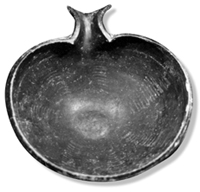
Materials from red soil area Maximum number of excavated sites are situated in red soil area covering the western parts of Birbhum, Burdwan, Bankura and Medinipur. The excavations have revealed a cultural deposit that varies in thickness between 1m and 2m. In most of the cases, the excavators have divided the cultural deposit into two phases on the basis of presence and absence of iron objects without taking much cognisance of the objective analysis of the material culture. The ceramic industry of this region comprises Black and red ware, Black ware, Red ware, Buff ware and Grey ware etc without much elaboration and sophistication in terms of quality, shapes and paintings on them. In the upper phase or period II, there was a clear sign of decay and degeneration in the material culture as indicated by coarse, gritty ceramic industry. This was followed by stagnation in economic growth. The industry comprises Channel spouted bowls, Bowls with flat-bottomed vases, convex sided bowls, Carinated bowls with splayed out rims, Vessels, Basins and Handis etc. The painting designs consisting of geometric forms and abstractions are found on black and red and red ware. The pigments were either white or black. The husk of rice grains found on the core of pottery suggests the domestication of rice as major crop. The rice grain has been identified with the domesticated variety of Oryza Sativa. But how far the cultivation of rice could meet the demand of total supply of foodstuff of the people is doubtful. Because the discovery of large quantity of microliths and bone tools at the lower level of Bharatpur and Mahisdal suggests that hunting continued to form a major part of their subsistence base. Moreover, the huge quantity of animal bones comprising both wild and domesticated species has been recovered from Bharatpur. Analysis of bone remains reveals that 71.93% belongs to domesticated stock like Buffalo, Humped cattle, Goat etc, while wild species are represented by 27.61%. It is, therefore, clear that the people of this region maintained large herd to supplement their subsistence economy. The high protein animals must have contributed sufficiently to their overall dietary system. It means that besides agriculture, cattle breeding were a major subsistence base.
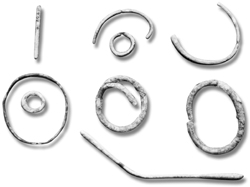
The impact of metal technology (copper or iron) was marginal on economic growth in this region. Despite tremendous potentiality of natural resources in the form of copper and iron ores, the people largely failed to utilise these resources to the best of their use. As such, the economy as a whole shows stagnation. No sophisticated urban elements are found to be present here. Paintings on pottery and metal technology show no further development. In fact, the economy of this region virtually remained unchanged over thousand years of their existence. The major reason for such stagnation in economic growth may be ascribed to less soil potentiality coupled with less rainfall. Naturally under such condition one cannot expect the development of specialised arts and crafts to meet the growing demands of sedentary habits. The people by and large were operating from more than one ecological base for their sustenance. The system thus evolved by them was good enough in agriculture cum hunting/gathering and pastoral economy, but it failed to generate much wealth for further prosperity and growth. Quite naturally almost all the settlements in this region ceased to exist before or immediately after the historical period.
Materials from old alluvium zone The excavated sites in this region are Pandu Rajar Dhibi, Mangalkot, Baneshwardanga and Pokhanna. The cultural deposit varies between 1.5m and 2.5m. Although the predication is not uniform in all the sites, the material culture reveals uniformity. The ceramic industry includes Black and red ware, Black ware, Red ware, Grey ware, Buff ware, Chocolate ware etc. Shapes include a variety of bowls including Channel spouted, Tulip shape, convex sided etc; Dish on stand, Vases, Basins, Beakers, Flower vases, Miniature pots etc. The painting designs as well etching generally found on black ware are exceptionally sophisticated and elaborate. The settlement areas are much larger than the lateritic zone. The impact of metal technology on economic growth was tremendous. The discovery of iron sickle at Pandu Rajar Dhibi and Axe and Chisel from Mangalkot suggests its role in agricultural economy.
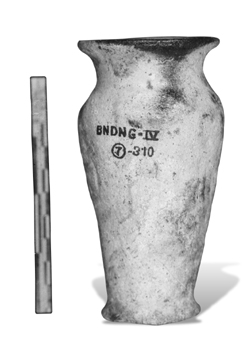
Microliths are almost nil in this region while bone artifacts (except at Pandu Rajar Dhibi) also did not play any significant role in the economy. The frequency of animal remains from excavation is not as high as that of lateritic zone. This may suggest that the people of this region were much more committed to agricultural than cattle breeding economy. The soil is highly potential for rice cultivation and rainfall in this region is also moderate. Subsequent development of different specialised crafts like creative art activities, ceramic industry, metal technology, stone bead technology, bone tool technology etc can be explained in terms of surplus production in the field. In fact, the people who occupied the old alluvium (Sijua formation) zone evolved a system, which later proved very much successful.
The people of this zone were operating from two ecological bases. On the one hand, they had their agricultural ecology in which Man-Land relationship became much more meaningful than ever before and on the other hand, they had semi-urban ecology in which the people had to meet the demand of semi-urban sedentary life-style. Quite naturally, the settlement areas have been substantially enlarged to accommodate the pressure of increasing population under sedentary life-style. The discovery of flower vases, beakers, semi-precious stone beads, flesh rubbers, ivory combs, pendants, bangles, earrings, antimony rods etc indicates the nature of sedentary practices. Consequently many semi-urban centres like Mangalkot and Pokhanna evolved into full urban centres during the early historic period, while Pandu Rajar Dhibi and Baneshwardanga failed to evolve into urban centres mainly due to the shifting of river courses.

Materials from new alluvium zone The third group of sites are found in the deltaic plains of lower Bengal particularly on the banks of Bhagirathi/Rupnarayan rivers. The soil of this region is good enough to support a stable agriculture base economy. The only excavated site in this zone is Tamluk or tamralipti. The excavation (1973-74) has revealed a four fold cultural sequence, of which period I, being the earliest, is characterised by Black and red ware culture. The ceramic industry comprises Black and red ware, Red ware, Black ware, Buff ware, Grey ware etc with different shapes and sizes. Paintings on pottery are both elaborate and sophisticated. A rich bone tool industry has also been reported. This region comprising a vast stretch of land in south Bengal is linked up with distant areas both by riverine and land routes. The people maintained their relation with the Chhoto Nagpur resource area for the supply of raw materials and they distributed their surplus commodities through the same routes. Consequently the wealth generated from such trade and commerce were utilised for overall economic growth.
This economic growth is reflected in the material culture of the people. By about 3rd century AD the people of this region were involved in an interactive trade with Southeast Asia, the evidence of such trade contacts are found in the form of archaeological materials from both the regions. Consequently tamralipti became an international port city in entire Eastern India. This kind of transformation has been documented in recent years with the discovery of many archaeological finds suggesting regular trade contacts between the two distant areas. [Asok Datta]
Bibliography A Datta, 'Chalcolithic Culture in West-Bengal - A study on Settlement And Transition', in A Ray and S Mukherjee (ed), Historical Archaeology of India, New Delhi, 1988, Black and Red ware Culture in West-Bengal, Delhi, 1995, 'Bengal and South-East Asia - Early Trade and Cultural Contacts', Journal of Bengal Art, No. 4, Dhaka,1998; Amita Ray, 'Chalcolithic Culture in West-Bengal', in Asok Datta (ed), Studies in Archaeology, New Delhi, 1991.
